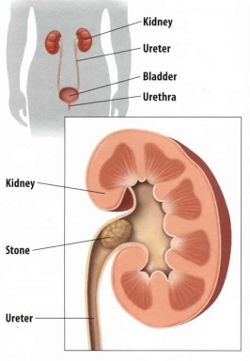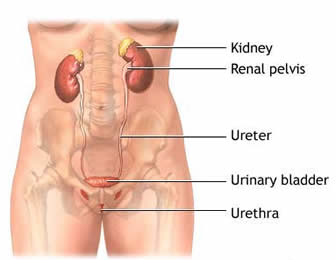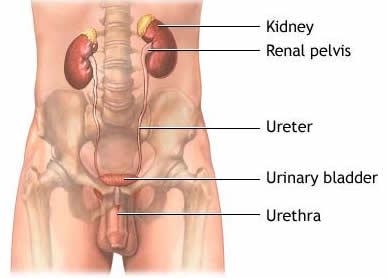Overview
This procedure has significantly changed the field of urology over the past 20 years. In the past, kidney stones were removed with open surgeries. Urologists devoted the majority of their time as “stone surgeons.” External shock wave therapy has almost eliminated open surgery for stone removal in the new er
a. The majority of small and medium sized stones will respond to one or more shockwave therapies.
Shock wave lithotripsy crushes a kidney stone that is still inside your body. It does not require any incisions. Instead, sound waves are sent through your body. When these sound waves hit the stone, it crumbles into tiny, sandlike pieces. As a result, it is easier for the pieces to pass through the urinary tract.
Although this therapy is quite successful, there may be an occasion to repeat the procedure if stone fragments become lodged in the urinary tract.
Possible Complications
- Infection
- Bleeding and/or bruising of the kidney
- Obstruction of the ureter (passageway from the kidney to the bladder)
- Failure of the stone to fragment
The Urinary Tract
The urinary tract rids the body of urine (liquid waste). The kidneys collect unneeded chemicals and water and make urine. This travels out of the kidneys through long, narrow tubes called ureters. The urine drains into the bladder, where it is stored until you are ready to urinate. It then leaves the body through the urethra.
When Kidney Stones Form
Chemicals in the urine can sometimes form crystals that have an appearance similar to sand. If the crystals stick together, they become a hard mass called a stone. The stone can get stuck in a kidney or ureter. This blocks urine from getting to the bladder, causing severe pain. There are different types of stones and the following descriptions will assist in the cause and prevention of them:
- Calcium stones. Roughly four out of five kidney stones are calcium stones, usually in the form of calcium oxalate. Oxalate is found in some fruits and vegetables, but the liver produces most of the body’s oxalate supply. Dietary factors, high doses of vitamin D, intestinal bypass surgery and several different metabolic disorders can increase the concentration of calcium or oxalate in urine.
- Struvite stones. Found more often in women, struvite stones are almost always the result of urinary tract infections. Struvite stones may be large enough to fill most of a kidney’s urine-collecting space, forming a characteristic stag’s-horn shape.
- Uric acid stones. These stones are formed of uric acid, a byproduct of protein metabolism. You’re more likely to develop uric acid stones if you eat a high-protein diet. Gout also leads to uric acid stones. Certain genetic factors and disorders of the blood-producing tissues also may predispose you to the condition.
- Cystine stones. These stones represent only a small percentage of kidney stones. They form in people with a hereditary disorder that causes the kidneys to excrete excessive amounts of certain amino acids (cystinuria).
Your lithotripsy procedure usually takes about an hour, and it will be done in our ambulatory surgery center (ASC)at our Fresno location. This is an outpatient procedure.
During the ESWL Procedure
- You will receive medication to prevent pain and help you relax or sleep during the lithotripsy procedure. Once this takes effect, the procedure will start.
- A stent (flexible tube with holes on each end) may be placed into your ureter. This helps keep urine flowing from the kidney.
- Your urologist then uses x-ray to find the exact location of the kidney stone.
- Shock waves are aimed at the stone and sent at high speed.
- If large stone particles remain after treatment, a second procedure may be necessary at a later time.
After the Procedure
- You will be monitored in our recovery room after your surgery. Antibiotics and pain medication may be prescribed before you leave.
- You will have a follow-up post operative visit in a few weeks. If a stent was inserted during your procedure, it will be removed. Your urologist will also check for pieces of stone. If large pieces remain, you may need a second lithotripsy, or procedure.
Passing the Stone
It can take a day to several weeks for the pieces of stone to leave your body. Drink plenty of liquids to help flush your system during this time you may experience:
- Your urine may be cloudy or bloody. You may even see small pieces of stone.
- You may have a slight fever and some pain. Take prescribed or over-the-counter pain medication as instructed by your healthcare provider.
Post-Operative Instructions
(Unless otherwise instructed by your physician)
Diet
Try to drink more liquid than normal, approx. three quarts a day minimum for at least five days.
Activity
Do not drive, drink alcoholic beverages, transact legal business, care for a dependent person, or take public transportation alone for 24 hours following surgery. Rest for the first 24 hours and increase activity as tolerated.
Urine Straining
Strain urine for stone particles for one week. Save residue in attached envelope or container and return it to the office for analysis. Additionally, x-rays of the kidneys will take place within 2-5 days if ordered by the physician.
Follow-Up Appointment
The recovery nurses will schedule a follow- up appointment before you leave the surgery center. It is important for your care that you keep that appointment; if the time and date are not compatible with your schedule, please call to reschedule within a few days of the original appointment.
Patient Expectations (up to 72 hours)
- Blood in urine
- Moderate to severe discomfort from sand particles passing
- Bruising of back or abdominal areas at the site of the shockwave treatment.
- Nausea for 24-48 hours.
- Minor fever of less than 101ºF for 24-48 hours
Contact Physician If…
- Pain, more severe than can be controlled with oral medication
- Fever greater than 101ºF for 24-48 hours
- Failure to produce urine for more than 8 hours
- Persistent nausea and vomiting
- Significant burning with urination



